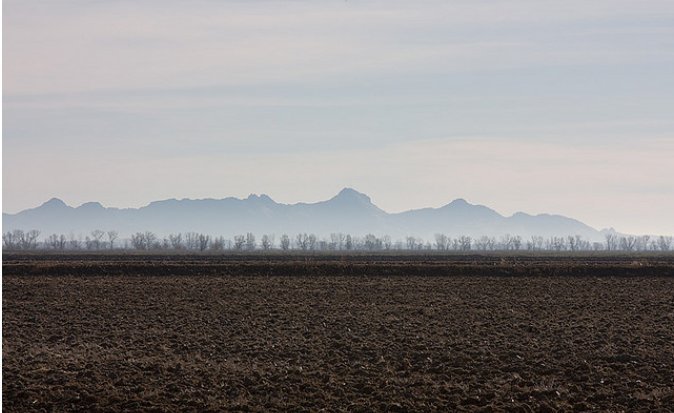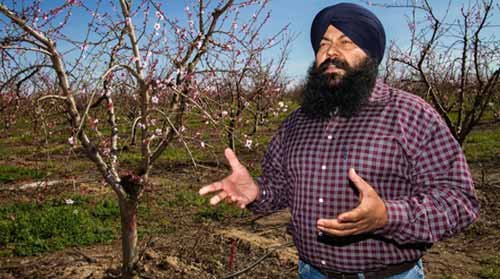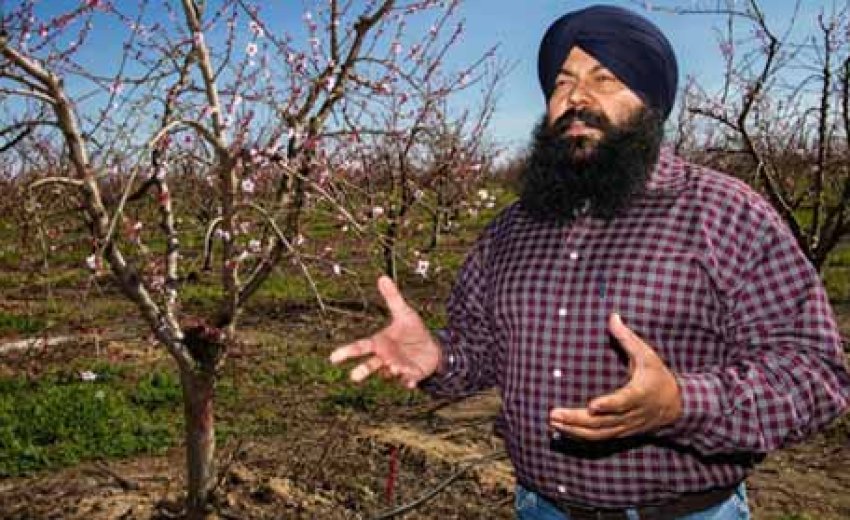 |
| Flickr/Alan Grinberg The Smallest Mountain Range in the World |
July 22nd, 2014: The farmland around Yuba City in Northern California produces almost the entire crop of the country's canned peaches, and two-thirds of its walnuts, almonds, pistachios and plums.
It's also home to a large and deeply-rooted Punjabi American community. But farmers there, like those across the state, are facing severe challenges due to the ongoing drought. [See full story below - Ed]
To talk about the history of the community in the area and the challenges that the current drought poses to local farmers, we're joined by two guests. Sunita Sohrabji is a reporter with India West. And Karm Bains is a grower whose family has been farming the area for generations.
---------------------------------
Indian American Farmers Weathering Record Drought in California
India West, News Report, Sunita Sohrabji
 |
| Above: Yuba City, Calif., farmer Karm Bains surveyed his peach orchards in early spring, after an extremely hot winter pushed out blooms too early. Indian American farmers in this region are preparing to take a $1 billion economic hit, due to California's severe drought. (Preston Merchant photo, courtesy of India-West) |
Jul 06, 2014 : YUBA CITY, Calif. — Didar Singh Bains, the legendary “peach king of California,” remains optimistic even as a severe California drought threatens to wipe out the $58 million agricultural business that his family has built up over seven generations.
The National Weather Service June 19 declared all of California to be under severe drought conditions. The California Department of Water Resources — citing one of the hottest winters in history and greatly-reduced snow-pack levels and reservoirs — announced May 6 that it would only deliver five percent of the water it would distribute in a normal year.
The state is currently holding only 17 percent of the water it would have at this time in normal years. Climatologists predict this is the beginning of a crisis the state will face each year, due to climate change.
California leads the nation in food production, generating almost $50 billion worth of agricultural goods each year. Indian Americans in this region, primarily from Punjab, who own an estimated 50,000 acres of land worth approximately $1.3 billion, grow almost the entire crop of the nation’s canned peaches, and almost two-thirds of its walnuts, almonds, pistachios and plums.
In a rare interview with India-West reporters who visited his home here — a modest structure that belies the 75-year-old farmer’s immense wealth — Bains said he believed his parched orchards could still be saved.
“I believe God will not let us suffer,” he said, as his son Karm, also a farmer, and grandson Barron nodded.
“I like my trees better than I like my friends. I can count my trees and how much money I will make,” joked Bains, who owns an estimated 16,000 acres of farm land and is likely the wealthiest Indian American farmer in the nation.
Bains left India in 1958 and arrived almost penniless in the U.S. He initially worked as a day laborer, saving most of his meager wages to build up his agrarian empire.
On a sunny spring day, as many orchards were beginning to bloom, several Yuba City/Marysville area farmers — including Yuba City Mayor Kash Gill, who is a farmer — held an informal briefing with India-West, discussing the severe economic impact the drought would have on their annual harvest.
Farmers said they had not adequately watered their trees during the critical bloom period, and would likely suffer from low or no yields.
Most stone fruit trees require four deep waterings per year simply to stay alive: a tree will die in the second year after a severe drought. Several farmers feared they would have to tear down their orchards and re-plant thousands of acres, which will not bear fruit for at least four years, leaving them without an income for at least six years.
This spring, many farmers shook the blooms off their trees in an attempt to conserve the overall health of the tree, said Mayor Gill, adding that fewer blooms will result in little to no fruit.
Row crop farmers who grow alfalfa, tomatoes and other produce said they plan to keep their fields fallow this year, and will also have no income.
Row crops yield $700 to $2,000 per acre, whilst fruit and nut trees yield approximately $2,000 per acre, Ajay Dhaddey, field operations manager for the California Canning Peach Association, told India-West. The income lost to Indian American farmers in this region could be over $1 billion.
“This year could break a lot of farmers,” Hardeep Bains, who grows prunes, almonds, pomegranates and walnuts, told India-West. “Mother Nature is doing exactly the opposite of what we need her to do,” noting that the hot weather had triggered an early blooming period when his trees should have been dormant.
The farmers noted that rice and grains receive subsidies from the federal government, but no such subsidies are available for growers of stone fruits and nuts. Furthermore, the value of such goods on the export market has been declining over the past decade, as area farmers attempt to compete with European farmers, whose products are subsidized (I-W, Jan. 12, 2005).
They also decried the distribution of water over which they have rights being diverted to Southern California. “The governor (Jerry Brown) is sending the water to where the rich voters are,” Karm Bains, Didar Singh Bain’s son, told India-West. “We have to be aggressive about water rights: this is our livelihood,” he stated.
The California Department of Water Resources announced its allocation plan May 6, saying it would deliver only 200,000 acre feet of water to the entire state. The DWR allocates water to residential and agricultural water contractors throughout the state, who had requested 4 million acre feet.
An acre foot of water is equivalent to 362,000 gallons. The average family uses about 146,000 gallons per year — 400 gallons per day — according to data from the U.S. Environmental Protection Agency; thus, one acre foot of water would serve about three families.
Therefore, the DWR’s entire allocation this year would serve only 600,000 households.
“This is not good news for anyone. Water availability this year is going to be one of the lowest we’ve ever seen,” DWR spokesman Doug Carlson told India-West. “We’ve got the sword of Damocles hanging over our heads.”
Levels of snow pack — which account for 37 percent of available water — are at their lowest since the mid-1850s, when California first began recording water levels. In a normal year, snow pack levels for May would be more than 17 inches.
The snow pack level on May 6 — the last day recorded for this year — was 2.5 inches.
Reservoirs are holding half of their normal capacity levels, said Carlson.
2014 was the hottest winter in history. The state went without rain for 52 days, he said, adding that not much precipitation is expected over the summer.
“This is a severe strain on the state’s agricultural industry and seriously impacts everyone associated with agriculture,” said Carlson.
An estimated half million day agricultural day laborers — who are paid only when work is available — are already suffering from little to no income this year during the peak summer stone fruit harvest. Packing and canning industries are also suffering from reduced agricultural products to distribute, and consumers nationwide are experiencing the effects of the California drought at their supermarkets.
Prices for all agricultural products — from winter wheat to beef to wine — are expected to soar this year and the next, said Carlson.
Many water contractors have banked water from “good” years, which they are likely to use this year to mitigate the impact of the drought, explained Carlson. But the scarcity of water availability is likely to make water much more expensive to purchase.
Raymond Bihala, a local banker and farmer of peaches, walnuts and row crops, told India-West that the cost of water has increased 100 percent over the past two decades. Water with the maximum price tag of $200 per acre foot in 1994 now costs between $2,000 and $2,500, he said.
As a result, bank loans have also become harder to obtain. "Banks are now looking for a consistent supply of water when they consider an agricultural loan," he said.
This spring, Bihala's walnut trees bloomed early, with the intemperate weather and no water, and looked like small caterpillars when India-West reporters visited his orchards. Bihala has shaken the blooms off of many of his trees, simply to keep them alive.
Compounding the issue of water scarcity are the tiny endangered fish known as smelt, which make their home in the San Joaquin river. Federal law mandates that salinization levels are kept consistent on the river, to preserve smelt and migrating Chinook salmon.
The San Joaquin River can also not be pumped for fresh water, to maintain adequate salinization levels for smelt and migrating Chinook salmon, in accordance with a 2007 U.S. District Court ruling, which mandates that water pumps in the San Joaquin-Delta River area — which supplies water to the Central Valley and Southern California — are shut off from December to June each year, severely curtailing water supplies to those regions.
“This is ridiculous. We are farmers with a passion for our livelihood,” Bains told India-West. “We’re all environmentalists — we have to be — but this is pitting fish against mankind.”
In March, California Sen. Diane Feinstein introduced legislation to allow maximum pumping in the area to mitigate the effects of the drought. The bill was denounced by environmentalists, who believed the measure could be the beginning of an effort that would ultimately destroy the habitat of the region.
The Emergency Drought Relief Bill — cosponsored by California Sen. Barbara Boxer — was unanimously passed by the Senate May 22; the measure allows for maximum pumping on the San Joaquin-Delta River area – with provisions to keep the smelt population healthy – until California Gov. Jerry Brown declares the state to be out of its drought emergency.
The Feinstein/Boxer bill also includes an initiative called WaterSMARTS, which would allocate emergency funding to communities disproportionately affected by the drought, including subsidies to help prevent the loss of permanent crops and mitigate the economic loss from this year’s drought. The amount of subsidies allocated to stone fruit and nut farmers was unknown.
Rep. John Garamendi, D-Calif., who represents portions of this area, told India-West reporters who visited his Davis, Calif., office: “The economic impact of this drought is profound and universal. Farmers are on the frontline of a crisis that will carry on to everyone in this state. Our communities are going to see a direct economic impact as water becomes unavailable.”
Garamendi has set out a plan for long-term water availability, which focuses on developing new surface and underground water storage systems and building new reservoirs.
Garamendi also recommends recycling water. In his water plan for California, the congressman noted the example of the Los Angeles Basin, which each year dumps 3.5 million acre feet into the Pacific Ocean.
“How foolish to pump water 500 miles, clean it, use it once, clean it to a higher standard than the day it arrives, and dump it in the ocean,” he stated, adding: “With adequate investment and implementation, urban and agriculture conservation, recycling programs and new storage could create approximately 5.7 million acre feet of new water to use each year at a projected cost of $7.8 billion.”
Garamendi denounced Governor Jerry Brown’s Bay Delta Conservation Plan, terming it a “$25 billion dollar boondoggle.” Brown was expected to discuss the BDCP later this week.
One Indian American, however, is profiting handsomely from the crisis. Nar Heer, founder of NorCal Pump, has 10 rigs that are drilling 20 to 30 wells per month — at a cost ranging from $250,000 to $1 million per well — and has a waiting list.
In the Yuba City/Sutter County areas, Heer told India-West his drills have had to dig at least 300 feet before finding water; in the Fresno Valley, water is found at 600 to 1,800 feet.
But the farmers — including Heer — all agreed that drilling for wells was simply putting a bandage on a long-ailing problem. Research money must be allocated for new methods of obtaining water, such as desalination, and better purification methods to mitigate what is likely to be an annual crisis.
“Peach king” Didar Singh Bains remained brightly optimistic, despite the dark forecast. The septagenarian — who visits his orchards every day and has weathered 56 years of drought, floods and blight — was hit when a 100-foot tree fell on him, shattering his right knee and ankle. He spent more than eight months in the hospital, but post-rehabilitation, has continued his hands-on work in his orchards.
“We must accept it; one year there is drought, the next year it may be better,” said the Sikh American pioneer.

